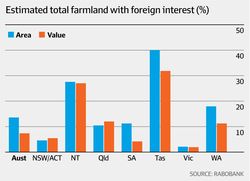Seeds of A Revolution
Defining The Disruptive Geopolitics Of The Global Farms Race
Defining The Disruptive Geopolitics Of The Global Farms Race
Foreign Investment In Australian Farmland ‘Overstated’?
July 26th, 2019
This entry was posted on Friday, July 26th, 2019 at 5:12 am and is filed under Uncategorized. You can follow any responses to this entry through the RSS 2.0 feed. You can leave a response, or trackback from your own site.
July 26th, 2019
Via Australia’s Financial Review, a report on foreign investment in Australian farmland:
Foreign ownership of Australian farmland is “overstated” when measured on a dollar-value basis, according to a new report by agribusiness lender Rabobank.While Rabobank found that 13 per cent of Australian farmland by area has some form of foreign ownership interest – in line with the most recent figures reported by the federal government’s Agricultural Land Register – by value this figure almost halves to just 7 per cent.“Focusing on land area … overstates the extent of foreign ownership of agricultural land,” said the bank in commentary on its latest report.According to Rabobank’s Agricultural Land Price Report, Tasmania has the highest level of foreign farmland ownership by value (40 per cent) ahead of the Northern Territory (just under 30 per cent), Queensland and WA (both just over 10 per cent).Victoria – at about 2 per cent – has the smallest percentage of foreign-owned agricultural land by value, with South Australia and NSW/ACT all also below 10 per cent on a value basis.By commodity type, the report found that foreign investment is most prevalent in Australia’s horticultural industries (crops such as almonds, citrus and grapes), with foreign interests accounting for 36 per cent of this sector by area and 23 per cent by value.The next-biggest sectors are livestock and crops, with foreign interests accounting for about 8 per cent of ownership by value and similar levels of ownership by area.The acquisition of Australian farms by cashed-up foreign investors has been a sensitive issue in recent years, with many local farmers unable to compete amid a surge in rural values.Since 2015, foreign investors have been required by law to register their interest in agricultural lands, while last year new rules kicked in requiring the public advertising of farms worth $15 million or more in a move aimed at giving local buyers an opportunity to compete for properties.“Foreign investment is heavily weighted towards livestock production [coming in at 96 per cent by area],” said Rabobank agricultural analyst Wes Lefroy.“Pastoral grazing land is however of less value compared with other production types such as cropping and horticulture,” he said.Mr Lefroy said foreign and corporate investment, rather than family farms, has tended to be more focused in on horticultural production, “underpinned by positive outlook in permanent crops and the scale and high capital costs involved in some of the new developments”.The most recent Agricultural Land Register figures published by the Foreign Investment Review Board show foreign investors increased the size of their Australian agricultural land holdings by 4.1 per cent to 52.6 million hectares in the 12 months to June 2018, with Britain, China and the US the top-three largest holders.Earlier this year, WA’s biggest grain grower, John Nicoletti, sold his 200,000-hectare wheat and wool portfolio in the state’s eastern wheatbelt region to the Saudia Arabian government for about $65-$70 million.Mr Nicoletti defended his decision to sell to the Saudi Agricultural and Livestock Investment Company, saying local investors had shown little interest in buying the massive aggregation.At the same time, some foreign owners such as China’s Rifa Salutary are quitting Australia.Rifa put its entire beef and lamb business, including 44,000 hectares of production land, up for sale this month after swinging to a big loss in the past year due to drought.
This entry was posted on Friday, July 26th, 2019 at 5:12 am and is filed under Uncategorized. You can follow any responses to this entry through the RSS 2.0 feed. You can leave a response, or trackback from your own site.
Leave a Reply
You must be logged in to post a comment.
About This Blog And Its Author
Seeds Of A Revolution is committed to defining the disruptive geopolitics of the global Farms Race. Due to the convergence of a growing world population, increased water scarcity, and a decrease in arable land & nutrient-rich soil, a spike of international investment interest in agricultural is inevitable and apt to bring a heretofore domestic industry into a truly global realm. Whether this transition involves global land leases or acquisitions, the fundamental need for food & the protectionist feelings this need can give rise to is highly likely to cause such transactions to move quickly into the geopolitical realm. It is this disruptive change, and the potential for a global farms race, that Seeds Of A Revolution tracks, analyzes, and forecasts.Educated at Yale University (Bachelor of Arts - History) and Harvard (Master in Public Policy - International Development), Monty Simus has long held a keen interest in natural resource policy and the geopolitical implications of anticipated stresses in the areas of freshwater scarcity, biodiversity reserves & parks, and farm land. Monty has lived, worked, and traveled in more than forty countries spanning Africa, China, western Europe, the Middle East, South America, and Southeast & Central Asia, and his personal interests comprise economic development, policy, investment, technology, natural resources, and the environment, with a particular focus on globalization’s impact upon these subject areas. Monty writes about freshwater scarcity issues at www.waterpolitics.com and frontier investment markets at www.wildcatsandblacksheep.com.
